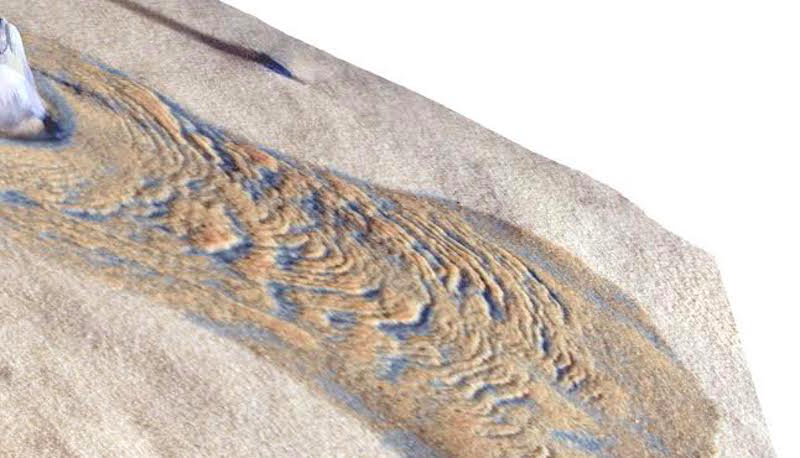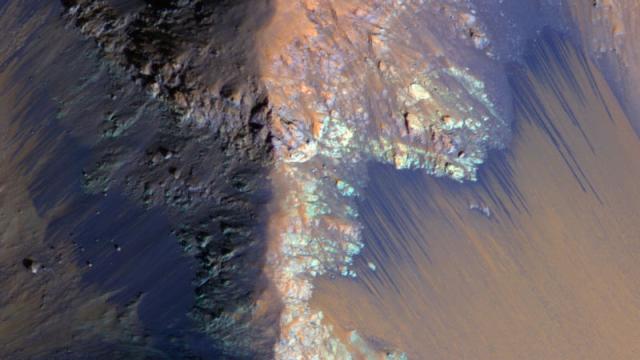Researchers just uncovered an incredible fact about liquid water on Mars. It’s not just flowing; it’s also boiling. And that discovery also solves one of the major mysteries about the surface of the red planet.
The results of a new experiment published today in Nature Geoscience detail how scientists made the finding and what it means. Researchers built a chamber simulating the conditions and atmosphere of Mars, then put ice in there to melt. The ice did melt and the water from it flowed — but there was also a surprise. The surface of the water boiled as it flowed, and that boiling was strong enough to move not just the water but also dirt and debris surrounding the streams. Importantly, temperature was not the major factor in this boiling water. It was due to the pressure of the atmosphere.
“The atmospheric pressure on Mars is very low compared to that on the Earth, which means that water boils at a much lower temperature than it does on Earth,” co-author of the paper, Susan Conway, told Gizmodo. “On the Martian surface the pressure is five to 10 millibars meaning that liquid water boils no matter what the temperature is.”
But, surely if the surface of Mars had boiling water etching out its plains, we would have seen it in more than just experimental conditions, right? That’s where the most exciting part of the research comes in. It turns out, we’ve already seen it happen. We just didn’t know what we were looking at.
Even before scientists confirmed the existence of flowing water on Mars, they’d long suspected it, particularly due to some images showing landscapes on the planet changing with the seasons. In these images, you can even observe the water as it (very, very slowly) flows from season to season, like in this gif showing Martian slopes transitioning from spring to summer.

The warmer it gets, the further the water flows, even though, technically, the summer temperatures should be too cold. This is because, instead of the water we’re used to seeing in our own streams and rivers here on Earth, the water that flows on Mars is a salty-brine which lowers the freezing point of the water, kind of like antifreeze. Even that explanation, however, still leaves a major unanswered question — and one that, until now, scientists were pretty unsure about how to solve.
We know that water flows on Mars today, and the salty brine explanation gives us a method by which it can happen. But, the changes we’re observing are huge, big enough to observe in pictures snapped from far away from the planet. Meanwhile, the amount of water flowing is fairly small and, from the looks of it, rather slow. So how does water manage to carve out the landscape so quickly and visibly?
The boiling water theory solves this problem. Because the water hits a boiling stage along its surface, it kicks up dust and dirt and debris in the water’s wake. In their experiment, the research team saw the boiling water move debris, but they also saw collapses along the sides of the flows. It’s not just the water flow. The boiling and the disturbance it causes etches those lines on Mars out clearly enough for our satellites to glimpse them.

Image: Hillshade digital elevation model for the final morphology produced by a water flow in martian conditions / M. Massé
New discoveries about water on Mars are never just about water, though. The research also gives us hints about the presence of life. However, the news is not great for the existence of life there, says Conway.
“[Our results] show much less water is needed and that the water that is produced is very short-lived — therefore not a fabulous environment for micro-organisms,” she told Gizmodo.
Still, even if it may make life already on Mars less likely, it is something to keep in mind for future life, namely our own colonization plans.
“If a future Mars colony wanted to build canals on Mars,” said Conway, “then they would have to be careful to design them in order to avoid this boiling effect, which could result in erosion of the canal banks.”
That’s pretty far in the future, though. In the meantime, we can now watch the water flowing on Mars with a much better understanding of just how it’s moving around up there.
Image: Coprates Chasma, 2014 / NASA/JPL/University of Arizona
